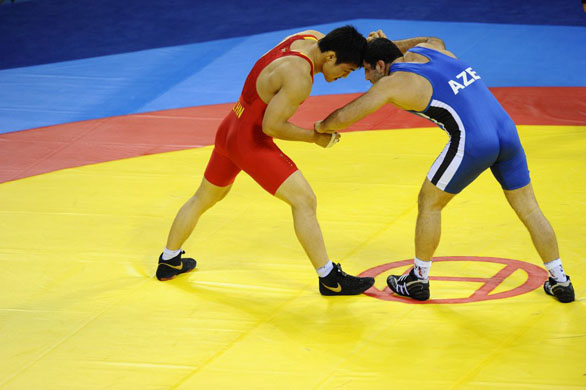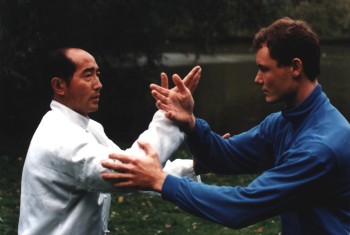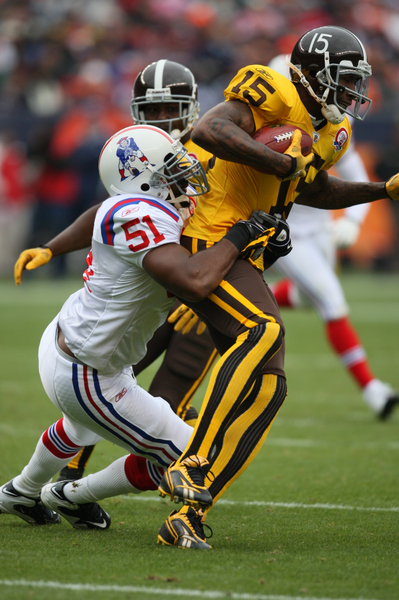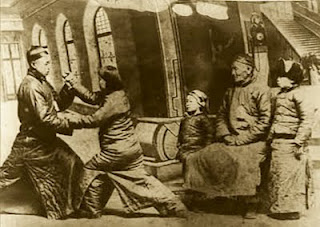What is Double Weighted?
/What does the term Double Weighted mean? This term became a problem because one of the five Tai Chi Classics boldly states something to the effect of--if you've practiced for a long time and you still suck at push-hands, it's probably because of 'double weighting.' I am going to settle the question of what Double Weighting means once and for all, definitively smashing all ambiguity asunder.
Allow me to first try and preempt any possible death threats by explaining that there are indeed two important and useful skills which others have tried to label "double weighting" but which are a terrible match for the term.

The first is a skill any good stand up wrestler can often acquire quite quickly simply by practicing a lot with a partner. If Bob and Joe are locked in a stand up struggle and Joe transmits all of Bob's force through his body to just one of his feet, he makes himself very vulnerable. However, if Joe knows this he can align himself such that he can suddenly change the transmission of Bob's force from one foot to the other. This creates an opening for Joe to attack if Bob tries to chase the force transmission going in-between Joe's feet. Maybe it doesn't sound that simple but anytime you see two Greco-Roman Wrestlers locked in a standup battle, that's what is happening. In Tai Chi push-hands practice because the spine stays vertical, this particular skill is counter intuitive, but it is still an effective beginning strategy. So it is often taught that--if one fails to shift his partner's force from one foot or the other, he is double weighted. One can see how if Bob's force and Joe's weight are both going to one foot it might be called double weighting. But that's a mistake this skill should really be called something like a 'clinch set up,' or a 'weight/force transfer reversal.'

The second fallacious usage of the term double weighting refers to the failure to conform to a basic matrix of push-hands skill. This can get quite complex but I'll try to make it simple. In upright push-hands if Bob and Joe are attached or connected in such a way that their mass can function momentarily as a single unit then it is possible for one of them to execute a throw using rotational force. However, a rotating mass can have only a single axis! Imagine the impossibility of trying to spin a globe which has two vertical axises. It just won't spin. To create a single axis for this type of finesse, Bob must spin his and Joe's weight entirely around a single vertical line going from one foot through his spine and head. The reason failure at this particular skill is wrongly referred to as double weighting is that people sometimes try to finesse it with their weight on both feet, and of course it fails. But why call this failure double weighting? It should be described in the affirmative as rotational throwing off of a single leg or around a singe axis! Why would failing at it need a separate name? Especially when there are actually a whole bunch of other ways this particular skill can fail.

So what does Double Weighted really mean? It means that you are carrying the weight of two people. Let me give some examples. Bob and Joe are now grappling on the ground. Bob tries to get as much of his weight on top of Joe as possible because Joe will find it harder to move if he is carrying Bob's weight in addition to his own. This is a very basic tactic of all systems of ground fighting. Make your opponent double weighted and they will find it difficult to move and will shortly run out of energy trying.
Here is another example:

The Football player in yellow is being forced to carry the weight of the player in white, thus, he is double weighted.
Now Tai Chi push-hands is a practice which generally has very little obvious momentum, so the use of mass and weight is a counter intuitive advanced skill. If Bob and Joe are pushing hands and are in contact and standing vertically and Joe feels Bob's weight on him, Joe is double weighted. The skill of giving the entirety of your weight to a push-hands opponent is a big advantage because when your opponent tries to move, he will be carrying you. In order to carry you he will have to expose the entirety of his structure. If you make the mistake of being double weighted in push-hands you are toast.
The main reasons most push-hands practitioners never learn the art of making someone else double weighted are listed here for your convenience: Loss of frame, folding in the kua, lack of awareness of the head, leaning, and the inability to create whole body unity via melting into emptiness.
It is important to remember that in the deadly spontaneity of defending oneself against a threat, having someone give you all of their weight is not the end of the world, it can be turned into an advantage-- it's a really bad situation, but we train for bad.

